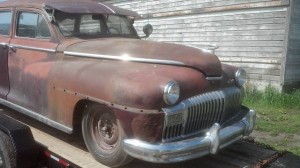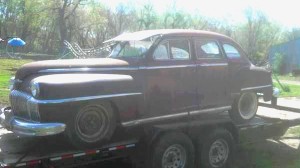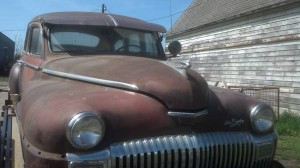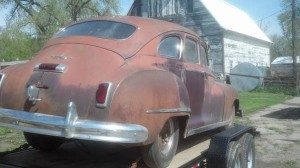We’ve had a run of nice DeSotos here on Barn Finds, but most have all been 1950s vintage. Nice early 50s “shoebox” era cars, and a little less recently, some later ’50s models with tall tail fins. All well and good, but there are those that like their cars…well…with a little more fat to chew on.
Once again, Barn Finds delivers. This “fat-fender” DeSoto dates from 1948. It’s nice to see the “bathtub” Packards of the era had some styling competition with this model. This one is offered for sale in Valley, Nebraska, just west of Omaha. The asking price is $1,600, and it appears here on craigslist.
The original color appears to be burgundy, which would really be unusual and attractive on a sedan from this era. The body looks sun-baked, but solid, and I’m going to guess this car probably spent a good part of its life further out in the West than it is now. The seller says it is a “fluid drive”, which is a rather interesting configuration, depending on which transmission it’s coupled with. As I understand it, it’s basically an early torque converter, but was used with either an automatic or a manual transmission. It’s purpose was to keep the engine from being stalled if the clutch were let out too quickly. I’d like to hear from our knowledgeable readers and commenters how efficient such a contraption was.
The seller says the car was driven into a barn around 10 years ago and parked since. In what looks like an otherwise attractive deal, the fly in the ointment is the seller’s intent to keep the valuable sun visor. Maybe it can be negotiated back into the purchase price. So what do you think? How do you like your DeSoto? Fat, finned, or shoebox?





For that price, it’s not too bad. the trim on the front fender might be hard to source, and it’s a shame he wants to keep the visor.
How bad is the interior? He doesn’t provide pics. Could be a nice family cruiser.
Find a roof rack and you’ve got Howard Cunningham’s classy ride…
That’s the first thing I thought when I saw that car!
What’s amazing is how good the chrome looks for a vehicle that’s been outside for a long time. I like this car, but the sunvisor would have to go with it.
Fluid Drive allowed the driver to avoid shifting gears after the Initial run through the 3 gears was complete. You could then pull away from a light or stop sign, no clutch, no, shifting. My ’49 Custom is equipped with Fluid Drive.
It looks to be a 1948 DeSoto Custom Suburban 8-passenger sedan. Maroon was a factory color.
Fluid Drive refers to a fluid coupling between the clutch and the crankshaft. It doesn’t multiply torque the way a torque converter does, but it’s similar. It allowed the car to be stopped while in gear with the engine running and the clutch engaged, and eliminated most of the need for finesse in driving a manual. The clutch pedal was only required when operating the shifter.
http://www.allpar.com/mopar/fluidrive.html
Speaking of the shifter, Fluid Drive was often (but not necessarily) coupled with Chrysler’s M6 semi-automatic transmission, which upshifted when you took your foot off the gas above a certain speed. Not clear if this car has it or not.
http://www.allpar.com/mopar/m6.html
Sounds complicated but it’s really simpler than a typical automatic transmission. The one in my ’51 Chrysler works perfectly and has never been rebuilt.
Perfect description.
Joe………perfect description of how it worked. Our family had a 1948 Chrysler Windsor 6 and it was essentially the very same transmission. The only problem was acceleration if the driver chose to not shift down to a lower gear on take off from a red light. The car was agonizingly SLOW. A couple years back I was test driving a 1950 Windsor 6. The acceleration from a red light stop was so slow, embarrassingly so, that I always chose to shift down in traffic for more speed, and still cars would stack up behind me!!. Fast take off was not so important in 1948 as it seems to be today. Oh, the Humanity!!
Yep, mine is really slow too. Just over 100 hp is no match for 4000 lbs of car. Once it gets up to speed it’s nice and smooth though. These cars will not be hurried; they proceed in a leisurely fashion at all times. I like that because it forces me to slow down and enjoy the scenery, which helps transport me back in time to an era when these cars were new.
Also, I secretly enjoy obstructing furiously impatient 1-percenters stuck behind my ’51 in their shiny new Audis.
Trickie, consider that these cars were built before the Interstate highways. High speed was not needed. Most speed limits were under 50 mph.
These were widely used as Taxi Cabs in larger cities along with the Checker Cabs because they were built like tanks and were huge inside.
Desoto’s were also available in a long wheelbase model that had two jumpseats so five people could be seated in the rear.
Love it. reminder of Trump’s great times when they were. I’m not sure this one is a Surburban. The Cunningham’s I think was the Surburban I think, it was a longer wheel base with more passenger room, more like a limo. Whatever it is a keeper and I know the sunvisors bring good money but if I bought it it would come with it.
Yes, I think Howard Cunningham’s DeSoto was a ‘burban. One of my dream cars is a DeSoto Suburban .. big as a house in & out!
My father’s opinion, and he died in 1959, was that Desotos were just as good as Chryslers, they shared a lot of parts, were a bit less expensive, but were for people too modest to own a Chrysler. Status as it related to cars meant a lot more in those days, his boss had a Buick (Roadmaster) so we could have a Pontiac or a Chevy but not an Olds or a Buick, unless it was an 88 or a Special. And the dark red/maroon that Chrysler had in the late 40’s was really nice, as was the Ford red.
Long ago I drove an early 50s Mopar with fluid drive. … The above is correct. Slow and mushy. No comparison to my ’55 Firefight Hemi and early torqueflight.
Chrysler Corp had 3 transmission offerings from the early 40s thru the early 50s. The 3 speed manual, The 3 speed manual with Fluid Drive and a 4 speed semi automatic with fluid drive. Fluid Drive was/is a viscus coupler between the crankshaft and the Clutch. Through the years the 4 speed semi-automatic had several different names. Simplimatic, touch-o-matic, shift and go, and Hy-Drive to name a few. There were speeds 1 & 2 in the (standard shift pattern) second gear position and 3 & 4 in the third gear position. You could (using the clutch to place the shift lever) start off in first or third. You needed the clutch to shift from the 1-2 position to the 3-4 position. In either range lifting your foot off the accelerator let the transmission up shift automatically. If you went through 1&2 and then shifted to the high range you usually ended up in 4th.
It was basically the same design that GM offered in 1937 and 1938 on 6 cylinder Oldsmobiles and the Buick Special. The GM offering was troublesome and dropped. Hydromatic came in in 41 I believe.
Chryslers touch-o-matic served them well into the 50s and is/was considered a great unit. The Fluid Drive was a great clutch saver which made cars so equipped such great cabs.
Hydramatic became available in 1939 when the 1940 model year cars were introduced. Hydramatic also required expensive annual service. Chrysler’s fluid drive did not.
The fluid drive was as described in many of the comments above but one feature not mentioned was the “hill holder” You could put it in any gear on an uphill with the clutch out and it would not roll backward like you would have the problem with a standard shift. I had a 47 Dodge with fluid drive and I don’t think it was any more sluggish than the standard shift but it sure didn’t have much in the horsepower division. But turn on the key and just touch the starter button and that old six was purring like a kitten. The fenders had rusted off and were tacked on with sheet metal patches and had been painted with rustoleum and a brush, but she kept on running……..
Ahh yes, Hill Hold and don’t forget Chysler’s “Chair Height Seating”.
Now I like the visor and the spotlight and especially the center trunk light. My dad’s first car was a 48 Dodge, he still had it when I was a little kid, I used to play on it (was locked so I couldn’t play in it, darn!) anyhow it had the center trunk light. Having never had any cars from the ’46-’48 era with the center trunk light, (I recall all Mopars and some Pontiacs that vintage having such a light) what was its purpose? Was it a brake light? (similar to what was required later on in 1986 for all cars) Sure didn’t see it on Fords and Chevys. Anyhow around 1963, my folks decided to add on to the house because there were more and more kids in my family (Catholics you know) so the Dodge got hauled away by the local junk yard, and they gave my dad $15 for it, and compression started it and drove it away. My dad said later that he saw the car being driven in Seattle, so it got sold as a driver to somebody, probably lasted a long time, only had 64,000 mi on it
Yes, the lights on either side of the rear deck lid emblem/lock are the brake lights. The taillights on the rear fenders are running/turn signal lights only.
DeSoto was the guinea pig for new options,engines,etc before they would be implemented into the Chrysler. The first Hemi was the Desoto Firedome before wearing the Chrysler Fire Power valve covers.
I learned to drive on a Hi Drive ’54 Plymouth. A great car to teach standard shift, since, you could run through the gears using the clutch, but, if you screwed up, you hadn’t needed to use the clutch from 2nd to 3rd anyway, just lift off the accelerator, and, it had the hill holder, so you could accelerate easily from a stop on a hill.
Then I transitioned to a ’51 Ford with a standard transmission and stalled it all the time, ground gears on occasion, and dreaded stopping on an uphill grade.
Comments from Howard, et al., have answered a mystery I’ve been perplexed by for 65 years: My family are all San Franciscans, and my maternal grandpa’s pride-and-joy was a ’48 DeSoto, complete with the suicide doors and the jumpseats (and, I believe, a spotlight on the windshield post!). I was eight years old then but many decades later, I would drive around my City, in my VW’s or MG’s, always wondering how my grandpa handled such a big car on streets which challenged drivers at every corner, every gradient, every cable car track! Somehow, my proud relative learned those skills–as he was obliged to, the DeSoto being his baby! (My grandmother, who never forgave the horse-and-buggy era for passing, called her mate’s car “the Machine!” (That name was always uttered with disdain.) My grandfolks lived in a San Francisco downtown apartment, and parking The Machine in an inside, scary parking floor was nerve-wracking. (In 1941, my folks bought the two-door version of the DeSoto, which had no such glamour as the big car, but did manage to cross the country several times.) It all must have seemed tame to them–for all four grandparents experienced, and survived, the 1906 Quake and Fire.
I like Big fender 30’s Desotos
So there ya go!
I owned two 1948 DeSoto Custops Fluid Drives for several years. Not quick or fast, but great cruisers. Startoff with the clutch, grab 2nd with the clutch or lifting, use the clutch for 3rd if you lifted for 2nd, or lift for 3rd if you clutched for 2nd. Had the Sunshield brand visors and the optional tube radios……best ice breaker wherever you roamed
oose to lift or cluhift into 2nd,